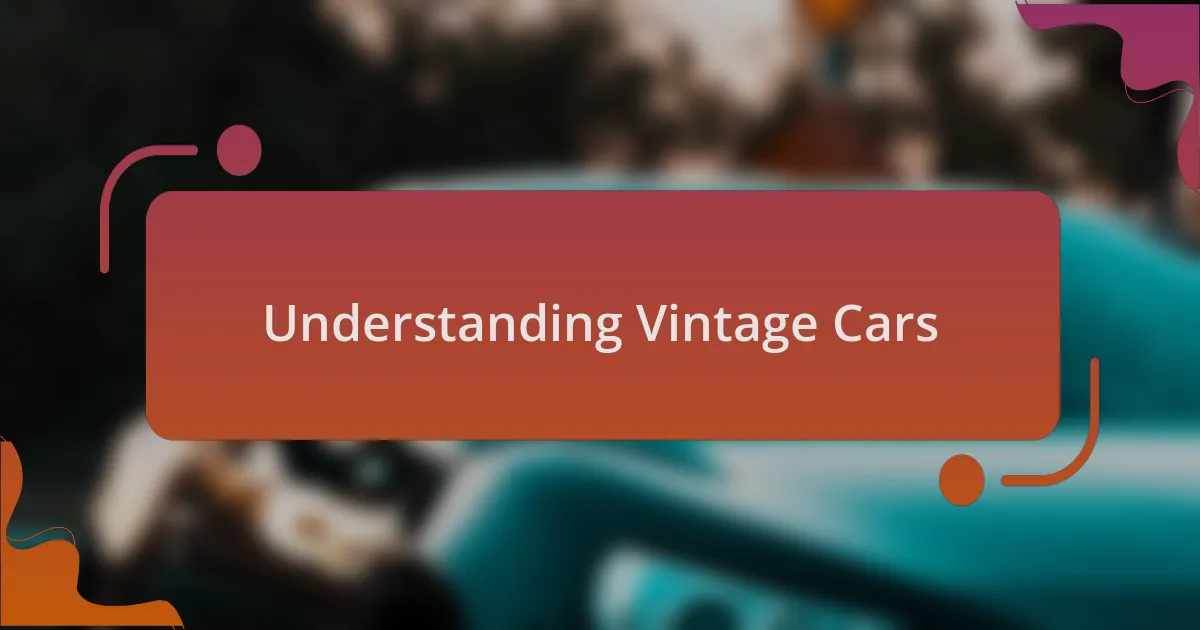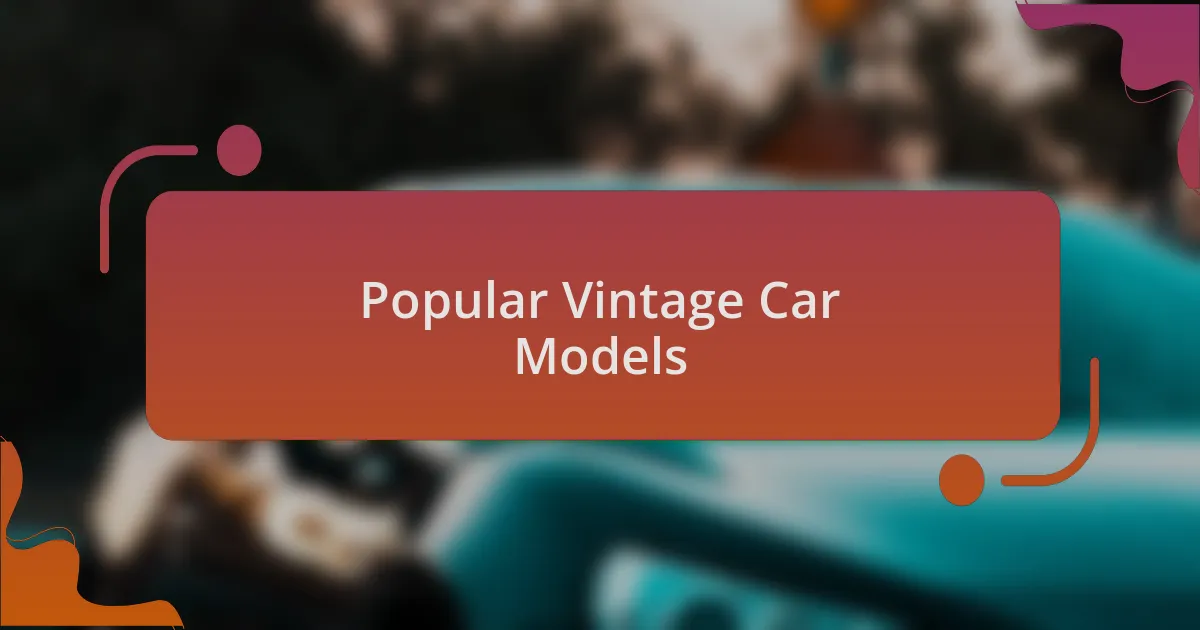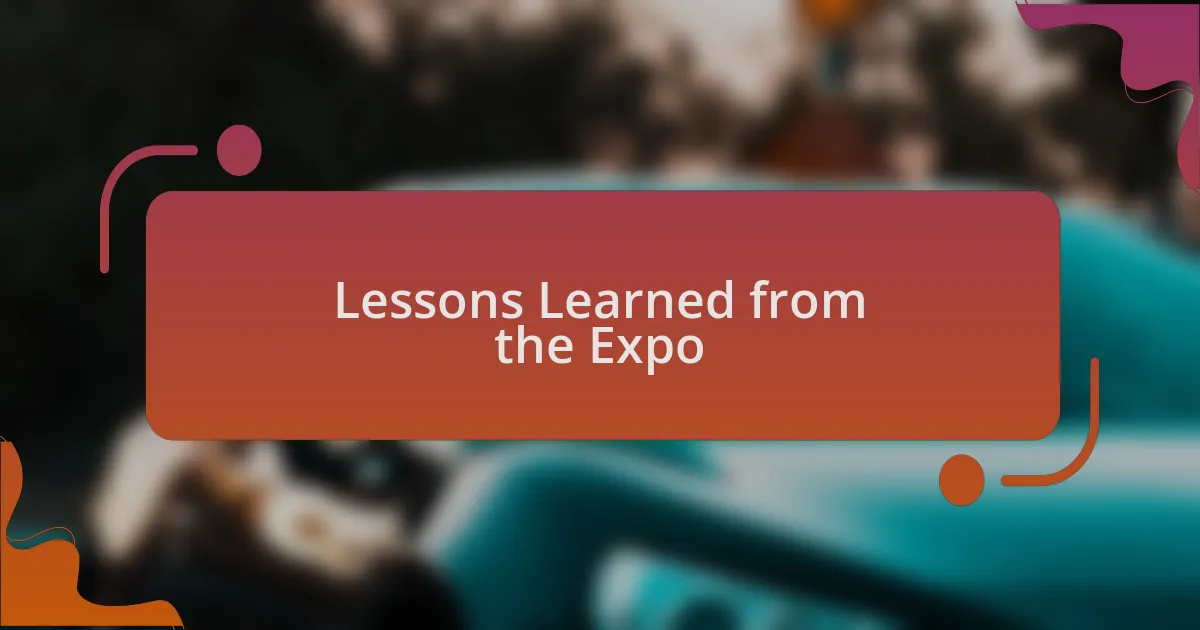Key takeaways:
- Different car categories evoke unique emotions; sports cars offer thrill, while vintage cars connect us to history.
- Vintage cars are valued not only for their craftsmanship but also for the personal stories and memories they carry.
- The automotive community enriches the experience of vintage car appreciation, highlighting the importance of shared passion.
- Preserving vintage cars is crucial for maintaining automotive history and ensuring future generations can appreciate these treasures.

Overview of Car Categories
When I think about car categories, I can’t help but recall my first encounter with a classic muscle car. The roar of the engine and its bold design instantly captivated me. It made me realize how car categories like sports, vintage, and luxury can stir different emotions in us. Each category tells a unique story, evoking nostalgia or excitement.
Sports cars are built for performance, and I remember taking a thrilling test drive in one. The sharp handling and acceleration left me breathless, making me wonder: what draws people to speed? I found that for many, it’s about the adrenaline rush and the sheer joy of driving. This category transforms a simple journey into an exhilarating adventure.
Then there are vintage cars, which hold a special place in my heart. Their aesthetic beauty reminds me of a simpler time, and I often find myself admiring the craftsmanship that went into designing them. When I see one on the road, I can’t help but ask myself: what stories could it tell? These vehicles are not just modes of transportation; they are rolling pieces of history that connect generations.

Understanding Vintage Cars
Understanding vintage cars goes beyond just knowing their age; it’s about appreciating the craftsmanship and history behind each model. I still remember the first time I saw a beautifully restored 1965 Mustang at a car show. The rich color, the gleam of the chrome detailing, and the roar of its engine brought so many memories flooding back. It’s fascinating how these cars can transport you to another era and evoke a sense of nostalgia.
What strikes me about vintage cars is the stories they hold. Each dent and scratch carries a tale, perhaps of long road trips or families gathered for Sunday drives. I once met an elderly gentleman who shared with me his adventures in a 1952 Chevrolet Bel-Air. Hearing him speak about his youthful days gave me a deeper appreciation for how these cars connect us, not just to the past, but also to each other. Isn’t it incredible how a mere vehicle can bridge generations and keep memories alive?
Moreover, understanding vintage cars means recognizing their place in the evolution of automotive technology. While modern cars are equipped with the latest gadgets and safety features, vintage cars reflect a time when driving was more about the experience than convenience. I recall a leisurely drive in a 1970s VW Beetle, where the simplicity of the car forced me to engage with the journey itself. It made me appreciate that sometimes, it’s the imperfections in design that make a car truly special, don’t you think?

Popular Vintage Car Models
Among the countless vintage car models, the 1957 Chevrolet Bel Air stands out for its blend of style and performance. I vividly remember attending a classic car rally where one of these beauties caught my eye—a stunning turquoise and white combination that looked like it had just rolled off the showroom floor. It’s remarkable how the fins and chrome details seem to encapsulate the exuberance of the 1950s, evoking a sense of freedom and adventure that’s hard to replicate today.
The iconic Ford Model T deserves a mention too, as it revolutionized the automotive industry. I had the chance to ride in a restored Model T during a vintage festival, and I was struck by how basic yet charming it felt. With no seatbelts and a simple crank to start the engine, I could genuinely appreciate the ingenuity of its design. It’s incredible to think that this car made driving accessible to the masses, isn’t it?
Then there’s the 1966 Jaguar E-Type, often regarded as one of the most beautiful cars ever made. Last summer, I had the privilege to sit in one belonging to a friend. I was captivated not just by its sleek lines but by the elegant interior, which felt like a luxurious time capsule. Driving it down a winding country road was exhilarating—every curve felt like a dance between man and machine. It’s moments like that where I truly understand why vintage cars evoke such passion and why they have a special place in the hearts of enthusiasts.

Personal Favorites from the Event
One of my absolute favorites from the event was the 1969 Ford Mustang Mach 1. I can still recall the thrill I felt the moment I laid eyes on its aggressive stance and deep, growling exhaust. It reminded me of my high school days when we’d drive around in our friends’ Mustangs, feeling invincible with the windows down and classic rock blasting. Isn’t it fascinating how a car can bring back such vivid memories?
Another standout was the 1955 Porsche 356. I remember walking up to it, and the first thing that struck me was the rich, glossy red paint that seemed to shimmer under the sunlight. Sitting inside, everything felt tailored to the driver—it was a cozy cockpit that exuded charm. I couldn’t help but ponder how this model captures the essence of simpler, yet exhilarating driving experiences, where the focus was purely on the joy of being on the road.
Lastly, the 1939 Cadillac Coupe offered an experience that felt like stepping back in time. I had the chance to chat with its owner, who shared stories of how he spent years restoring it to its former glory. Listening to him talk about the intricate details and the craftsmanship behind the design made me realize how much passion and dedication go into preserving these masterpieces. Isn’t it incredible how these cars live on, carrying with them tales of yesteryears?

Lessons Learned from the Expo
The Expo taught me that every vintage car has its own story, and understanding these narratives can deepen our appreciation for automotive history. I remember standing in front of a stunning 1957 Chevrolet Bel Air, mesmerized by its vibrant color and iconic fins. I found myself wondering about the countless families that may have created memories in that very car—how many road trips, summer vacations, or late-night drives could it recount if it could speak?
Connecting with fellow enthusiasts revealed another valuable lesson: the community around vintage cars is just as rich as the cars themselves. While chatting with other attendees, I realized that our shared passion transcended the metal and paint. Each conversation was laden with excitement, tales of restoration triumphs, and shared discoveries. It made me recognize the importance of community in preserving these pieces of history.
Lastly, the importance of preservation struck me like a bolt of lightning. As I examined a beautifully restored 1963 Corvette, I felt a rush of gratitude for the owners who dedicate their lives to restoration projects. I couldn’t help but think about how much effort goes into maintaining these classics, and it raised a question for me: What will future generations think if we don’t prioritize preserving these automotive treasures? It’s a reminder that our responsibility extends beyond just admiring vintage cars; we must also actively support their preservation.